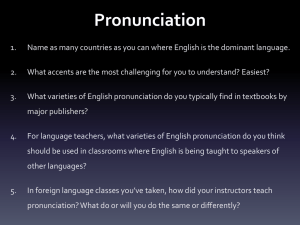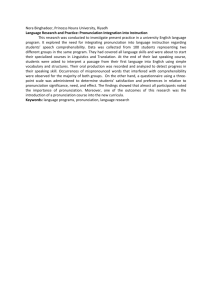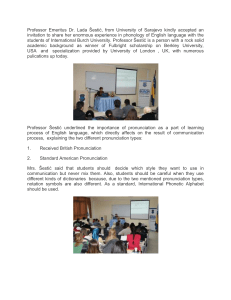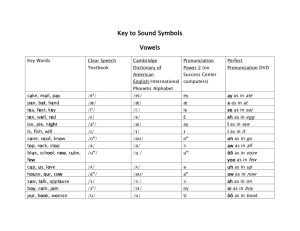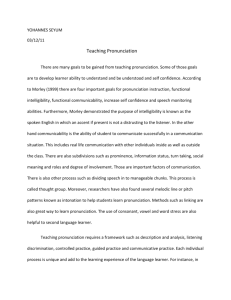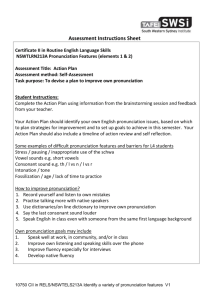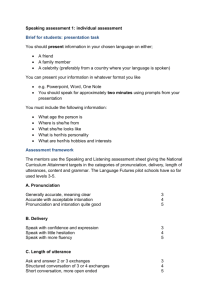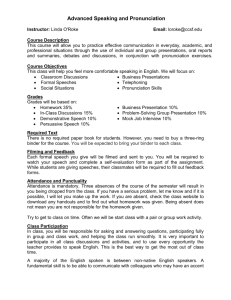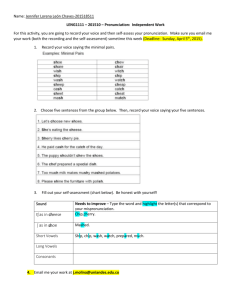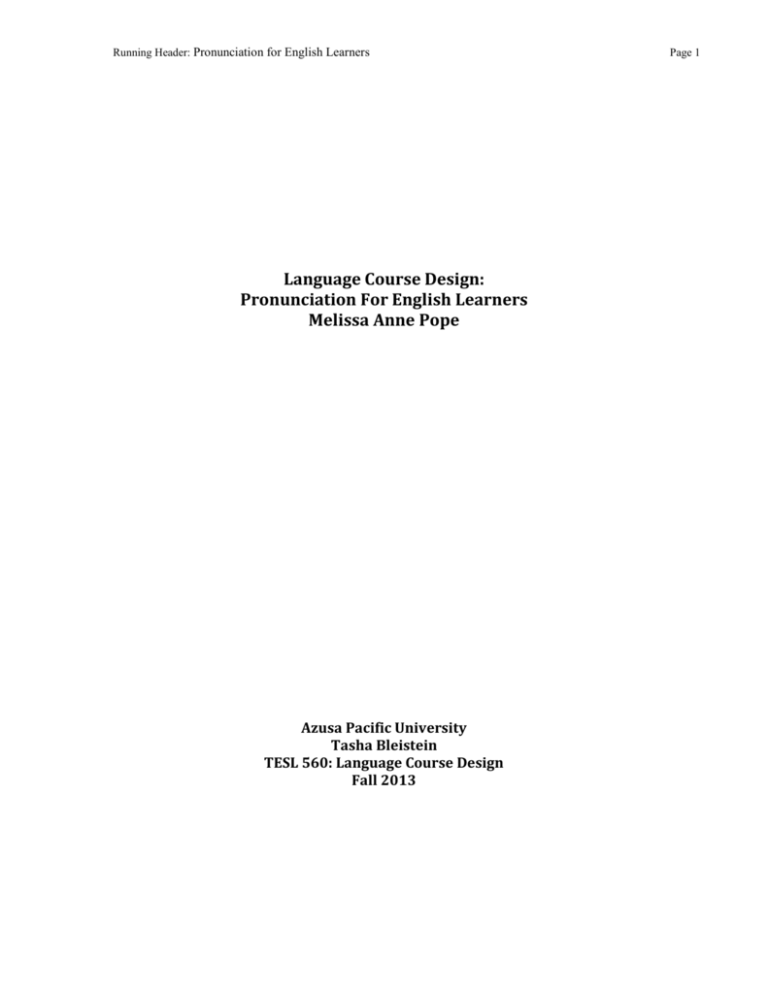
Running Header: Pronunciation for English Learners
Language Course Design:
Pronunciation For English Learners
Melissa Anne Pope
Azusa Pacific University
Tasha Bleistein
TESL 560: Language Course Design
Fall 2013
Page 1
2
Pronunciation for English Learners
Table of Contents
Chapter 1
Context
3
Chapter 2
Articulating Beliefs
5
Chapter 3
Need Assessment
8
Chapter 4
Learning Outcomes
12
Chapter 5
Course Syllabus
16
Chapter 6
Textbooks
19
Chapter 7
Course Assessment
22
Reference
24
Appendix
25
3
Pronunciation for English Learners
Chapter 1: Context
Valdosta Georgia is a small city of a little more than 57,000 that is located in
South Georgia. In the center of this small town sits Valdosta State University, a small
state school with about 12,000 students. The university offers a variety of liberal
arts degrees at the Bachelors, Masters, and Doctoral level. While Valdosta State
offers completive programs in business, science, and education, the city of Valdosta
has little to offer. Most incoming students quickly become bored with the lack of
dining and entertainment options. This is particularly an issue with students
moving from larger cities, such as Seoul and Jeddah. For this reason, many students
transfer after their freshman or sophomore year. This is one particular problem
found within the English Language Institute, ELI, at Valdosta State. Many students
arrive from overseas having lived in large cities. While this may be seen as a
drawback, I believe it has strengthened the program. Because many students would
rather live in a larger city, the ELI program must benefit students both personally
and academically. Hence, one goal at ELI is to comprehensively provide students
with necessary skills to excel in English language learning.
ELI courses take place in classrooms located in the department of social work
and the education department. Most classrooms are large with approximately 35
desks. While this is the classroom capacity, most ELI course consists of ten to 15
students. All classrooms are equipped with a teacher’s computer, a projector
mounted on the ceiling, and an over-head projector.
ELI students are predominately from four countries: Saudi Arabia, Japan,
South Korea, and China. A few students are from Honduras, Brazil, and other
Pronunciation for English Learners
4
countries. Classes are made up of about 70 percent male, and 30 percent female.
Students are between the ages of 18 and 24 with few exceptions. Almost all
students are hoping to attend an English speaking university. A small percentage of
students hope to attend Valdosta State, but most hope to transfer to a university in a
larger city. Some students are at ELI to only to improve their English skills and do
not plan to continue studying in an English speaking context; they have completed a
degree in their home country, or they are taking a semester or two away from their
degree program to study English.
The ELI program consists of two eight-week sessions in one semester. All
students are enrolled in Reading, Writing, Grammar, and Conversation. Each course
is Monday through Friday for fifty minutes. These courses are divided into six
levels. Students are required to take a placement exam for initial placement. Under
the current program, pronunciation is incorporated in the conversation course.
Because most students intend to continue their study at an English speaking
university, pronunciation is an important skill in their language learning.
Unfortunately, pronunciation skills are often lost in the greater spectrum of
conversation skills within our courses. For this reason, I have designed this
pronunciation course to be used in one of two ways, as an optional mini-course
offered after classes or to provide structured guidelines for teachers within the
conversation course.
Pronunciation for English Learners
5
Chapter 2: Articulating Beliefs
This course is designed with three foundational beliefs in mind. First,
affective filters effect language learning and should be addressed in the classroom.
Second, Communicative Language Teaching provides an approach to language
teaching that pairs well with pronunciation teaching. Finally, automaticity allows
for greater fluency in student’s speech. These three beliefs are discussed below and
form a foundation for this course.
Affective Filters
I believe that student learning is affected by how a student feels and how
motivated they are to learn. As I sat in an American university classroom, my
classmates stood, and read their homework answers in Spanish. I could think of
little else other than, “I might be next! What if she calls on me next! I’ll have to read,
in Spanish! What if I mispronounce a word and everyone laughs? What if they don’t
laugh and just completely have no idea what I’m saying?” My anxiety and fear of
speaking in front of the class drowned out the language knowledge being presented
by the teacher. This is an example of a student raising affective filters that impede
the language learning process.
Stephen Krashen included affective filters in his monitor model (Lightbown
& Spada, 2006). Affective filters are described as a wall of “feelings, motives, needs,
attitudes and emotional states” that “prevents learners from acquiring language
even when appropriate input is available” (Lightbown & Spada, 2006, p. 37). The
source of the affective filter can either be related to the course, or the student’s
personal life. By lowing affective filters, students feel more motivated to learn
Pronunciation for English Learners
6
English, and feel more relaxed in class (Lin, 2008, p. 117). Brown (2007) says, “Our
job as teachers is to provide the kind of warm embracing climate that encourages
students to speak, however halting or broken their attempts may be” (p. 324). This
course will include activities that are interesting to students to allow ease in
practicing communication. Students will also be asked to interact with groups of
students allowing trusted relationships to be formed. It is also advised that teachers
regularly communicate with students to encourage and show support.
Communicative Language Teaching
This idea of language learning translates into language teaching through the
Communicative Language Teaching approach. CLT states that communication is the
primary purpose of language, and “using language to communicate should be
central in all classroom language instruction” (Celce-Muricia, Brinton, & Goodwin,
2012, p. 8). This allows students to achieve language-learning goals, such “being
able to use the language for meaningful communication” (Richards, 2006, p.3). For
this reason, authentic materials and interactions need to take place in the
Communicative Language Teaching classroom. Language learning is further
achieved as learners are not only listening to the teacher, but interacting with peers
(Richards, 2006). Richards (2006) further states that CLT aids in the language
learning as a process by providing students opportunity to use language to negotiate
meaning, while having the freedom to use language in a trail and error manner.
Following the Communicative Language approach, this course uses authentic
materials to teach pronunciation. In addition, students will be asked to interact with
one another as they produce and identify various sounds within language context,
Pronunciation for English Learners
7
and not in isolation. These sounds will be used to communicate ideas and tasks that
are meaningful and relevant to the students. The foundation of this course will
focus on using language as a means of communication.
Automaticity
Native speakers most often talk with ease of communication without
hesitation. They do not think how to pronounce sounds or debate on which word is
best to use in a particular situation. This skill is lacking among non-native speakers.
Even though students may have the ability and knowledge to correctly pronounce a
sound, when engaged in conversation, they may not produce the sound correctly.
Automaticity will be encouraged in this course to best move students towards
language fluency.
Brown (2007) states, “Overanalyzing language, thinking too much about its
forms, and consciously lingering on rules of language all tend to impede this
graduation to automaticity” (p. 64). For this reason, rules and thoughtful practice
will be taught in this course to allow students to gain the needed skills to produce
sounds correctly. In addition, students will be required to practice sounds within
authentic conversations, and during exercises that require quick responses in order
to give students opportunity to practice automaticity.
Pronunciation for English Learners
8
Chapter 3: Needs Assessment
This language-learning course was created because correct pronunciation
needs were not being met in current courses. Students studying to improve their
English skills were in need of specific pronunciation instruction. Without targeting
their specific pronunciation needs, this course does not increase language learning.
Therefore, teachers will periodically gather information concerning students’ needs
and preferences. This information will be analyzed and then used to determine the
direction and content of the course (Graves, 2000). Most classrooms consist of
students that are at different levels, and have different native languages.
These needs assessments are necessary to provide the teacher with
information to determine which sounds should be covered during the two-month
course and what objectives can reasonably be achieved during this course. For this
reason, a needs assessment will be given on the first day of the course. Another
assessment will be given at the end of two weeks, and again at the end of week five.
Follow-up assessments are suggested by Graves (2000), “When needs assessment is
used as an ongoing part of teaching, it helps the learners to reflect on their learning,
to identify their needs, and to gain a sense of ownership and control of their
learning” (p. 98). As this course is designed for adult students, one program
objective is to provide students opportunity and knowledge in taking ownership of
their own language-learning process. Three needs assessments will be given in this
course to help meet program, course, and student goals.
These three assessments, as outlined in the Needs Assessment Plan table
below, will be a combination of felt needs and perceived needs (Graves, 2000). The
Pronunciation for English Learners
9
first needs assessment, given on day one, provides the teacher information
regarding the students’ felt needs – needs that the student feels he or she has. This is
done through the Pronunciation Questionnaire, which asks students about their
background and own thoughts on their pronunciation abilities and expectations (see
Appendix A).
The second and third assessment, given at the end of week two and five
respectively, focuses more on perceived needs – needs determined by the teacher,
and program. Week two needs assessment, refer to row two in the Needs
Assessment Plan table, will be a brief interview conducted between the teacher and
the student. During this interview, students will be asked to correctly produce
sounds taught during the first two weeks. Pronunciation will also be assessed
through informal observation during the interview. The teacher will also dialogue
with the student about individual and class goals and if these goals are being met
through this course. Students will also be asked to what pronunciation needs he or
she feels are not being met. This information will be recorded and later analyzed.
The content of the next three weeks will be based on this information. At the end of
week five, see row three of the Needs Assessment Plan Table, see Table 3.1, a
colleague will be asked to observe the pronunciation class. After being given
information regarding lesson plans with sounds and skills being taught, the
observer will attend a class and make note of sounds students mispronounce and
their frequency of mispronunciation. This class will include an activity that requires
students to communicate with one another using a variety of different sounds, both
previous taught and new sounds. This will take place within a dialogue activity to
Pronunciation for English Learners
10
emulate an authentic context. The colleague will then make recommendations on
what sounds still need to be addressed, and other needed changes based on
observations and program objectives.
Table 3.1: Needs Assessment Plan
When
Data
Procedure
Day One
Student
Questionnaire
pronunciation
background.
Student
expectations
End of
Week Two
End of
Week Five
Rationale
To learn what skills the
student feels they are needing
to improve. To obtain
information concerning the
pronunciation background of
each student. To know what
specific sounds students find
difficult.
Student
One-on-one
To acquire feedback on
perceived
Interview
changes made based on
pronunciation
questionnaire given on day
needs
one. To check pronunciation of
specific sounds. To obtain
information on content and
approach to the remainder of
the course.
Program
Observation/Review To obtain information about
expectation/
pronunciation errors in an
Student
authentic context. To receive
perceived
feedback on meeting program
needs
objectives being met in the
course. To better understand
program goals. To gain
information on needed
changes in the final two weeks
and upcoming courses.
The third needs assessment, observation/review, is designed to ensure that
not only student needs are being met, but all stakeholder needs are also being met
in this course. Richards (2001) references Connelly and Clandinin as defining
stakeholders as those whom have the “right to comment on, and have give input
into, the curriculum process” (p. 56). The director of this program has set specific
Pronunciation for English Learners
11
objectives to be met through program courses. This course design is aimed at
meeting program objectives while aiding students in language learning. For
example, this program is designed for adult learners intending to study at an English
university. The program objectives are designed to adequately prepare students to
study and excel academically within a native-English context. As students are
unaware of the pronunciation demands in this context, the needs of the program
will also be taken into account. After the observation, and review of lesson
objectives, the observer will be able to provide feedback giving the teacher
knowledge of program needs and if they are being met.
Pronunciation for English Learners
12
Chapter 4: Learning Outcomes
Proverbs 29:18 tells us that “Where there is no vision, the people perish”
(NKJ). This principle is true in the Kingdom of God as well as our language learning
classrooms. One responsibility we have as teachers is to cast a vision for our
students’ language learning process. This is done by creating goals and learning
objectives, for language learning courses. “Objectives are statements about how the
goals will be achieved. Through objectives, a goal will be reached” (Graves, 2000, p.
76). As we set a vision, or goal, before our students, learning outcomes need to be
established so that teachers, and students have a clear plan for how to reach those
goals.
The language learning vision, or goals, we have for our students’ learning
should reflect the purpose of the course. This ensures that learners are moving
towards language learning, and not just completing classroom activities. Richards
(2001) states that objectives are “a more specific and concrete description of
purposes” (p. 120). The goals for this course are like a brick wall standing plainly
for administration, teachers, and students to know where learners are headed.
Learning outcomes are the bricks that make up that wall. As the bricks are laid, a
solid foundation of learning outcomes provides a strong framework for the
program and course.
As suggested by Graves (2000), I have used Stern’s framework to construct
goals. The following goals and learning outcomes are intended to be used as
guidelines in conjunction with the needs assessments. Each class is different, made
Pronunciation for English Learners
13
of students with different pronunciation needs. Teachers should adjust outcomes
related to specific sounds according their individual class needs.
Proficiency Goal
By the end of this course, students will be able to identify pronunciation
errors of the target sounds, suggested for this context to be L, R, B, P, and V,
in themselves and in others.
Proficiency Rationale
Correct pronunciation of the target language is key to communication.
Students who do not pronounce sounds correctly “will have oral
communication problems no matter how excellent and extensive their
control of English grammar and vocabulary might be” (Celce-Murcia, Brinton,
Goodwin, p. 8). For this reason, students are required to recognize specific
sounds indicated by the needs assessments in this course.
Proficiency Learning Outcomes
1. By the end of this course, students will be able to identify at least five
pronunciation errors in a three-minute, non-native spoken dialogue.
2. By the end of this course, students will be able to locate target sound
pronunciation errors in their own speech from a five-minute recorded
dialogue between themselves and a classmate.
Cognitive Goal
By the end of this course students will be able to distinguish between the
different places of articulation and manners of articulation.
Cognitive Rationale
When correcting pronunciation errors teachers and students need to use the
same terminology to accurately describe places and manners of articulation.
This will aid in a more thorough description of how sounds should be
produced correctly and how they are being produced incorrectly. In
addition, students in this context are studying English in an academic setting.
Students completing this program should be able to communicate skills and
knowledge learned in an academic setting using academic speech.
Cognitive Learning Outcomes
1. By the midterm point of this course, students will be able to label all
speech organs on a printed sagittal diagram.
2. By the end of this course, students should be able to describe the place of
articulation and manner of articulation using anatomical terms for all
targeted sounds.
Affective Goal
By the end of this course students will be able to articulate the importance of
correct pronunciation.
Affective Rationale
Brown writes that teachers should “focus less on how to administer
immediate or tangible rewards and more on how to get students in tune to
14
Pronunciation for English Learners
their potential and to be challenged by self-determined goals” (Brown, p. 94).
As students become aware of the importance of correct pronunciation, they
develop own personal pronunciation goals based on their individual desires
and needs. This allows for students to be challenged and encouraged to be
better English speakers instead of simply receiving a high score in the course.
Affective Learning Outcomes
1. By the end of this course, students should be able to state their own belief
on the importance of sounding like a native English speaker using their own
pronunciation practices and goals to support that belief through a written
essay.
Transfer Goal
By the end of this course, students should be able to produce the target
sounds and determine the best method to continue their own pronunciation
learning with sounds mispronounced.
Transfer Rationale
The purpose of a language-learning classroom is for students to improve
language skills for communication outside the classroom. It is important that
students continue language learning after this course to ensure languagelearning progress that allows for easy communication within a native context
or a monolingual, English-speaking context.
Transfer Learning Outcome
1. By the end of this course, students will be able produce target sounds at
least twice in word initial and word final positions in a spontaneous dialogue.
2. By the end of this course, students will be able to list activities that aided
in correct pronunciation of specific sounds and develop a plan for further
learning by listing activities, time-frames, and sounds on a calendar.
Table 4.1, Language Learning Goals and Learning Outcomes
Framework
Proficiency
Goal
By the end of this course
students will be able to
recognize pronunciation
errors of the target
sounds, L, R, B, P, and V,
in themselves and in
others
Learning Outcome
By the end of this course
students will be able to
identify at least five target
sound pronunciation errors
in a three-minute, non-native
spoken dialogue.
By the end of this course
students will be able to
locate target sound
pronunciation errors of their
own speech in a five-minute
recorded dialogue between
themselves and a classmate.
15
Pronunciation for English Learners
Cognitive
Affective
Transfer
By the end of this course
students will be able to
distinguish between the
different places of
articulation and
manners of articulation.
By midterm of this course,
students should be about to
label all speech organs on a
printed sagittal diagram.
By the end of this course,
students should be able to
describe the place of
articulation and manner of
articulation using anatomical
terms for all targeted sounds.
By the end of this course By the end of this course,
students will be able to
students should be able to
articulate the
state their own belief on the
importance of correct
importance of sounding like
pronunciation.
a native English speaker
using their own
pronunciation practices and
goals to support that belief
through a written essay.
By the end of this course, By the end of this course,
students should be able
students should be able
to produce the target
produce target sounds at
sounds and determine
least twice in word initial
the best method to
and word final positions in a
continue their own
spontaneous dialogue with a
pronunciation learning
non-native speaker.
with sounds
mispronounced.
By the end of this course,
students should be able to
list activities that aided in
correct pronunciation of
specific sounds and develop
a plan for further learning by
listing activities, timeframes, and sounds on a
calendar.
16
Pronunciation for English Learners
Chapter 5: Course Syllabus
A course syllabus communicates the design, organization, and expectations
for the course. This allows for administration, teachers, and students to better
understand what will be taught, how it will be learned, and basic course
information, such as time, location, and instructor. Graves (2000) defines a syllabus
as “the product of organizing and sequencing a course” (p. 125). As this course was
developed, I created a course syllabus (See Appendix B) to provide information
about it’s organization, sequence, and purpose. The framework I used was a skillsbased syllabus. Richards (2001) identifies speaking as a macroskill and suggests
using a skill-based syllabus when designing a course that addresses microskills,
which underlies macroskills (pg. 160). This course focuses on the microskill of
pronunciation to increase students’ speaking ability.
Course Organization
The purpose of this course is for students to increase their pronunciation
resulting in greater communication through speaking. A secondary purpose is for
students to better understand how sounds are produced and establish personal
goals for correct pronunciation. For this reason, I have organized this course
according to skill-based instruction because it focuses on teaching students “to learn
the specific language skill” of pronunciation, as opposed to teaching general
communication functions (Reilly, 1988, pg. 3). While students will be expected to
produce and identify the target sounds within authentic speaking contexts,
achievement will be based on production and identification of individual sounds.
This course teaches three units over eight weeks.
Pronunciation for English Learners
17
Course Units
As started above, the primary purpose of this course is for leaners to increase
pronunciation skills. Secondly, this course was designed for learners to understand
production of sounds and set personal goals. This information is divided into three
units. Unit one addresses how sounds are produced. Unit two addresses production
and identification of specific sounds. Unit three address the importance of
pronunciation and the strategies needed to set personal pronunciation goals.
Unit one, Anatomical Features of Sound Production, is covered during weeks
one, two, and three. This information will be used during the following weeks to aid
students in fully understanding how sounds are pronounced incorrectly and what
changes need to be made for correct pronunciation. This unit is divided into three
parts: Speech Organs, Point of Articulation, and Manner of Articulation. One part
will be taught each week. In addition, during these same three weeks, unit three will
be taught. This unit, Pronunciation Benefits, explains why pronunciation is
important and enables students to create personal goals for individual learning.
During week one, students will learn the effects of incorrect pronunciation in
authentic contexts. During week two, students will reflect on their own English
learning needs and consider how pronunciation directly effects communication.
Week three will equip students with the knowledge needed to set individual goals
specifically for this course.
Unit two, which addresses the main purpose of this course, will be covered
during of weeks four through seven. This unit, Sounds, focuses on specific sound
production and identification. The suggested target sounds have been divided into
18
Pronunciation for English Learners
consonants and vowels. Consonants are taught over three weeks and vowels over
one week. Consonant sounds are taught according to manner of articulation – stops,
fricatives, and approximants. Approximants and vowels are to be taught last as they
are often times most difficult for learners.
The three units covered over eight weeks work together to meet the goals of
this course. Table 4.1 shows where course goals are represented in the syllabus.
Table 4.1 Course goals and units
Course Goals
By the end of this course students will be
able to recognize pronunciation errors of
the target sounds, L, R, B, P, and V, in
themselves and in others
By the end of this course students will be
able to distinguish between the different
places of articulation and manners of
articulation
By the end of this course students will be
able to articulate the importance of
correct pronunciation.
By the end of this course, students
should be able to produce the target
sounds and determine the best method
to continue their own pronunciation
learning with sounds mispronounced.
Course Unit
Unit 2, Sounds
Unit 1, Anatomical Features of Sound
Production
Unit 3, Pronunciation Benefits
Unit 3, Pronunciation Benefits
19
Pronunciation for English Learners
Chapter 6: Textbooks
Textbooks are printed materials used for instruction and reference that
provide students with exercises and activities to aid in learning. These are typically
books designed with created materials for the specific commercial purpose of
teaching English. Students, teachers and administrators benefit from the use of
textbooks. First, students “know what to expect, and they know what is expected of
them” (Graves, 2000, p. 174). It also offers students with a variety of visuals, tables,
and reference guides that teachers are unable to construct in the classroom.
Textbooks also benefit teachers as “they save teachers’ time, enabling teachers to
devote time to teaching rather than materials production” (Richards, 2001, p. 255).
They also provide teachers, especially new teachers, with valuable resources to aid
in understanding skills, presenting in class, and a variety of activities (Richards,
2001). Lastly, textbooks benefit administrators as they have clearly stated “what
will be learned and in what order” (Graves, 2000, 174). In addition, textbooks allow
for consistency within a program, across courses and levels (Graves, 2000). For
these reasons, textbooks are highly valuable in the language-learning classroom.
While textbooks facilitate language learning, there are some disadvantages.
The main disadvantage that would present itself with using a textbook in this course
is that textbooks cover a specific sound set, or all North American English sounds.
As stated in the course goals, this course is designed to specifically target those
sounds that each individual student is mispronouncing. This is supported by
Richards (2001) when he states that textbooks are “often written for a global
market” (p. 255). In an effort to encourage teachers to focus on mispronounced
Pronunciation for English Learners
20
sounds discovered in the needs assessment, I have designed this course to be used
without a textbook. While textbooks provide a syllabus and direction for a course
that is often needed, this can also be counter-productive in meeting specific learner
needs. In addition, this course is not designed as a serious of courses. This course is
designed for any level learner to acquire knowledge in specific sound production,
and how to continue independent further study. Textbooks provide valuable
information and benefit language-learning; a comprehensive set of teacher
resources should be used in lieu of a textbook. I am advising a pronunciation
resource book, various websites, and an activities book for teachers to use in this
course.
Course Recommendations
There are there main goals for this course: learning targeted sounds,
understanding pronunciation basics, and setting goals for further study. To assist
teachers in meeting the needs of presenting and instructing target sound
production, I recommend The Pronunciation Book by Marks and Bowen and
published by Delta Publishing. This book demonstrates clearly how to pronounce
English sounds and offers information on how to teach students. This teacher
resource also provides needed information for teachers to use while instructing
students in pronunciation basics, such as speech organ names and points of
articulation. To meet the third goal I suggest using the website MindTools, (See
Appendix C). This site provides the reasoning behind setting goals and practical
steps needed in creating those goals. For teachers wishing to use a textbook, I am
suggesting Better English Pronunciation published by Cambridge University Press.
Pronunciation for English Learners
21
This text not only offers detailed instruction of each sound, but also the reasoning
behind improving pronunciation. However it is intended to used by the teacher as a
reference. These are the resources I recommend, but I have provided other
resources that may be used to meet specific class needs in Appendix C.
Pronunciation for English Learners
22
Chapter 7: Course Assessment
This course in pronunciation exists to aid students in language learning – to
meet their language needs. While this is the course purpose, this course should also
meet the needs of the teachers, as well as program administrators. Therefore a
course assessment is needed to determine how this course meets the needs of all its
stakeholders. With assessment results, administrators and teachers will best be
able to make necessary changes to better aid students in language learning. The
procedures for the assessment plan of this course consist of a final exam taken by
students at the end of the course, a classroom observation preformed during the
course, and a questionnaire given to students, teachers and administrators at the
end of the course (See Appendix D).
The assessment procedures for the three groups of stakeholders focus on the
three main purposes of evaluation. Richards explains, “The different purposes for
evaluation are referred to as formative, illuminative, and summative evaluation”
(Richards, 2001, p. 288). Formative evaluations “find out what is working well, and
what is not” (Richards, 2001, p. 288). This should take “place as the course is in
progress and [provide] information about how well the students are doing” (Graves,
2000, p. 208). The second purpose of evaluations is illumination evaluations. This
purpose focuses on how the course is being implemented and “seeks to provide a
deeper understanding of the processes of teaching and learning that occur in the
program” (Richards, 2001, p. 289). The final purpose of an evaluation is summative.
Summative evaluations aid in “determining the effectiveness of a program, its
23
Pronunciation for English Learners
efficiency, and to some extent with its acceptability” (Richards, 2001, p. 292). Chart
7.1 shows how each purpose is addressed with each stakeholder.
Chart 7.1 - Evaluation Purposes
Purpose
Stakeholder
Formative
Student
Teacher
Administrator
Illuminative
Student
Teacher
Summative
Student
Teacher
Administrator
Example Questions
Is the workload to heavy
for the course? Is the
course enjoyable?
Does the text/handouts
aid in teaching the
objectives and learning
outcomes?
Is there enough time to
adequately cover the
material needed to
achieve the learning
outcomes?
What issues occurred with
students/teachers during
the course? Where
students/teachers
complaining about the
text?
Through observation:
Which students are
active? Do students
understand instructions
and the lesson?
Through observation:
How does the teacher use
the lesson plans? How
interactive is the teacher
with students?
Analysis of final exam
scores.
What changes need to be
made to objectives? Was
this course useful in
student learning?
Did students and teachers
enjoy this course? Where
methods/approaches
appropriate for program
goals?
24
Pronunciation for English Learners
References
Brown, H.D. (2007). Teaching by Principles: an Interactive Approach to Language
Pedagogy. White Plains, NY: Pearson Longman.
Celce-Murcia, M. Brinton, D. M., Goodwin, J. M., & Griner, B. (2010). Teaching
pronunciation: A course book and reference guide. New York, NY: Cambridge
University Press.
Graves, K. (2000). Designing language courses: A guide for teachers. Heinle: Boston,
MA.
Lightbown, P.M., and Spada, N. (2006). How languages are learned. Oxford: Oxford
University Press.
Lin, G. H. C., (2008). Pedagogies proving Krashen’s theory of affective filters. Hwa
Kang Journal of English Language & Literature, 14, 113 – 131.
Reilly, T. (1988). Approaches to foreign language syllabus design. Retrieved from
ERIC database. (ED 295460).
Richards, J. C. (2006). Communicative language teaching today. Cambridge
University Press: New York, NY.
Richards, J. C. (2001). Curriculum development in language teaching. Cambridge
University Press: New York, NY.
25
Pronunciation for English Learners
Appendix A
Pronunciation Questionnaire
Name __________________________________________ Course Name _______________________
Date _________________
In the space provided, write your answer to each question. Circle the answer to
each question when choices are provided. Please answer each question honestly. If
you do not understand the question, write “I do not understand.”
‘Produce’ means how you make the sound when you are speaking.
‘Identify’ means if you hear the sound when listening.
1. What is your native language?
2. Do you have difficulty with any sounds in your native language - either in
production or identification? Write a word with the sound and underline the
sound.
3. What other languages do you speak?
Second Language __________________________________________________
Are you fluent? Yes No
Third Language __________________________________________________
Are you fluent? Yes No
4. What sounds in your second/third language do/did you find difficult to
produce or identify? Write the word and underline the sound.
5. How long have you formally studied English?
More than 10 years
less than 1 year
5 to 10 years
4 years
3 years
2 years
6. Have you ever taken an English pronunciation course? Yes
1 year
No
7. Have you ever studied English pronunciation as part of a course? Yes
No
26
Pronunciation for English Learners
8. What percentage of producing English sounds do you think you have
mastered?
100% 90% 80% 75% 60% 50% 45% 30% 25% 10% 5%
9. What percentage of identifying English sounds do you think you have
mastered?
100% 90% 80% 75% 60% 50% 45% 30% 25% 10% 5%
10. Do you believe the production of sounds can cause miscommunication?
Why, or why not?
11. How often does the production of sounds cause miscommunication in
your speaking?
Never
Almost Never
Sometimes
Frequently
Always
12. Do you believe the identification of sounds can cause miscommunication?
Why, or why not?
13. How often does the identification of sounds cause miscommunication in
your listening?
Never
Almost Never
Sometimes
Frequently
Always
14. How important to you is improving your English pronunciation?
First priority
Very important
Not very important
It’s a waste of time
15. What is your goal in pronunciation? Do you want to sound like a native
speaker, or do you only want to be able to communicate in English?
Native American Speaker
Native British Speaker
Communicate in English
16. What are three English sounds you find difficult to produce? Write the
letter representing the sound and a word with that sound.
1.
2.
3.
27
Pronunciation for English Learners
17. What are three English sounds you find difficult to identify? Write the
letter representing the sound and a word with that sound.
1.
2.
3.
18. How does studying pronunciation make you feel? Circle ALL that apply.
Excited Happy Confident Grateful Stressed Overwhelmed Defeated
Bored
19. How much do you expect your pronunciation to improve in the next two
months?
Greatly
A lot
Some
Very little
None
I don’t know
20. Please write about any thing else you want to say about pronunciation –
studying pronunciation, your current ability in pronunciation, or
pronunciation in general.
28
Pronunciation for English Learners
Appendix B
Course Syllabus
Valdosta State University
ENGLISH LANGUAGE INSTITUTE
Pronunciation Course Syllabus
ESLP 1003
Instructor: Melissa Pope
Office Hours: Monday – Friday 8:00 – 9:30 am, ELI Office
Contact Information: mapope@valdosta.edu
214.733.3206 (Do not call past 9 pm.)
Course Information: ESLP 1003 Pronunciation Level Two
Pine Hall Room 113
Monday - Friday 3:00 – 3:50
Course Materials: No book is required for this course.
Course Description and Rationale:
Prior to this course, students will have completed level two grammar and
conversation. This course is designed for ESL learners who wish to improve their English
pronunciation in order to communicate effectively in native and non-native contexts. It
teaches correct pronunciation of common English sounds and seeks to enable learners
to better understand the importance of pronunciation in communication. It also seeks
to develop the learners’ individual learning strategies by teaching students to recognize
pronunciation errors in their own speech and how to best correct these errors.
Learning Outcomes:
At the end of this course,
-you will be able to identify pronunciation errors in your speech and other’s speech.
-you will be able to produce the eight target sounds.
-you will be able to describe how sounds are produced and identify speech organs.
-you will be able to explain your personal pronunciation goals and beliefs.
Student Expectations:
1.
2.
3.
4.
5.
6.
7.
Attend every class on time
Complete ALL assignments by the due date (Late work will not be accepted)
Only Use in English in class, unless otherwise permitted by the teacher
You are responsible for doing your best in class and on assignments
Respect others and listen when they are talking
Ask questions when needed
NO CELL PHONES
29
Pronunciation for English Learners
Grades:
Grading Scale
Assignment Weights
90 - 100 = A
80 - 89 = B
70 - 79 = C
60 - 69 = D
0 - 59 = F
10%
15%
15%
20%
40%
Homework
Quizzes and minor assignments
Presentation
Tests
Final Exam
Course assignments
Homework will be given daily and collected the following class. No
Homework
Quizzes
Minor
Assignments
Presentation
Tests
Final
late homework will be accepted.
Five written quizzes will be given on Friday’s to cover material
covered during the week.
This includes identification and production exercises given
throughout the course.
A five-minute dialogue will be required where learners produce the
target sounds and identify these sounds in their classmates’
presentations.
Two tests will be given to evaluate knowledge of sound production
organs, point and manner of articulation of target sounds, and
sound identification of the target sounds.
The final will include a spoken presentation of goals and strategies
to continue correct pronunciation of the target sounds. These
sounds must be explained and pronounced correctly in the
presentation.
Tentative Course Outline
Week
Skills
Week One
Speech Organs
Why Pronunciation Matters.
Week Two Place of Articulation
My Beliefs on Pronunciation
Week Three Manner of Articulation
Setting Personal Goals
Week Four Stops: Target Sounds /p/ and /b/
Week Five
Fricatives: Target Sounds /f/ and /v/
Week Six
Approximants: Target Sounds /l/ and /r/
Week
Vowels: Target Sounds /ey/ and /iy/
Quiz and Tests
Quiz 1
Needs Assessment
Quiz 2
Test 1
Quiz 3
Quiz 4
Test 2
Presentation
Pronunciation for English Learners
Seven
Week Eight
Strategies for Continued Practice
Review
Final Exam
Goals Evaluation and Setting New Goals.
*Target sounds are a suggestion based on the context but should be
modified to fit specific learner needs within the course.
30
31
Pronunciation for English Learners
Appendix C
Textbook and Website Recommendations
Textbook
Publisher
Ordering
Information
Review
Better English
Pronunciation
Cambridge
University Press
Cambridge.org
Fricatives Booklet
Seattle Learning
Company
Pronunciation.com
Pronunciation
Games
Cambridge
University Press
Amazon.com
Pronunciation
Practice Activities: A
Resource Book for
Teachers
Cambridge
University Press
Amazon.com
This book provides
students and
teachers with
background
information on why
pronunciation
should be studied. It
will help learners to
better articulate
their language
learning goals.
This book is great
when paired with
Stops and Affricates,
and Vowels Booklet.
It provides
instructional for
learners in
pronunciation of
sounds.
This book is a
wonderful resource
of activities to aid in
pronunciation. It
offers a variety of
activities with a
teacher’s guide and
printable materials.
This book offers a
complete view of
pronunciation basics
and key vocabulary.
It also offers a brief
over of advanced
skills such as rhythm
and intonation. This
book provides
activities for the
classroom with
accompanying
handouts and audio.
This is a great book
for beginning
teachers.
32
Pronunciation for English Learners
Stops and Affricates
Booklet
Seattle Learning
Company
Pronunciation.com
The Book of
Pronunciation
Delta Publishing
Amazon.com
Vowels Booklet
Seattle Learning
Company
Pronunciation.com
This book is great
when paired with
Fricatives, and
Vowels Booklet. It
provides
instructional for
learners in
pronunciation of
sounds.
This book is a
complete
pronunciation book
for teachers. It
offers rationales for
learning
pronunciation,
explanation of basic
knowledge, and
sound production
instruction. It also
includes some
activities.
This book is great
when paired with
Stops and Affricates
and Fricatives
Booklet. It provides
instructional for
learners in
pronunciation of
sounds. I would
recommend this
book for teachers
targeting vowels
sounds.
33
Pronunciation for English Learners
Website
Address
Description
Carnegie
Mellon
Academic
Development
http://www.cmu.edu/acadev/fastfact
/Academic%20Goals08.pdf
Kantis
Simmons
http://kantissimmons.com/725ways-to-set-and-achieve-all-of-youracademic-goals/
http://www.mindtools.com/page6.ht
ml
This site outlines how to be
successful in setting goals.
It has practical
recommendations and
offers encouragement for
achieving goals.
This site outlines eight keys
to setting, and achieving
academic goals.
This site explains the
reasoning behind goal
setting and aids in knowing
where to start and how to
write achievable goals.
This is a great resource for
teachers and students. This
site offers videos on how to
pronounce sounds, words,
and phrases in isolation
and context. It gives
detailed, easy to follow
academic instruction for
sound production.
MindTools
Rachel’s
English
http://rachelsenglish.com/
34
Pronunciation for English Learners
Appendix D
Course Evaluations
Pronunciation Course Evaluation
Observation Form
Date __________________________
Record your answers on the lines below each question
1. Did students participate in group activities?
_________________________________________________________________________________________________
_________________________________________________________________________________________________
2. Did students volunteer answers or ask questions during class?
_________________________________________________________________________________________________
_________________________________________________________________________________________________
3. Where students confused during the lesson presentation?
_________________________________________________________________________________________________
_________________________________________________________________________________________________
4. Did students completely understand directions for activities?
_________________________________________________________________________________________________
_________________________________________________________________________________________________
5. Did the teacher utilize the board during instruction?
_________________________________________________________________________________________________
_________________________________________________________________________________________________
6. Did teachers and students use the text/handouts for instruction?
_________________________________________________________________________________________________
_________________________________________________________________________________________________
Pronunciation for English Learners
35
7. Did the lesson work towards learning outcomes?
_________________________________________________________________________________________________
_________________________________________________________________________________________________
8. Did the teacher interact with students: talk with students/offer help when
needed?
_________________________________________________________________________________________________
_________________________________________________________________________________________________
9. Did students appear engaged in the lesson?
_________________________________________________________________________________________________
_________________________________________________________________________________________________
10. Were students able to complete specified tasks by class end?
_________________________________________________________________________________________________
_________________________________________________________________________________________________
36
Pronunciation for English Learners
Appendix F
Stakeholders Questionnaire
Pronunciation Course Student Questionnaire
Date __________________________
Circle the number that best answers the question.
1 – Yes. This is true and describes exactly how I feel.
2 – This is true, but changes could be made to make it better.
3 – This is not true, but changes to the course do not need to be made.
4 – No. This is not true. And changes to the course need to be made.
1. There was too much homework in this course.
1
2
3
4
2. I learned a lot in this course.
1
2
3
4
3. The handouts helped me to improve my pronunciation.
1
2
3
4
4. I wish we had a textbook for this course.
1
2
3
4
5. I liked having this course at the end of the day.
1
2
3
4
6. This course should a part of the conversation course.
1
2
3
4
7. It would be helpful to have this course for one hour.
1
2
3
4
8. I know how to help my friends improve their pronunciation.
1
2
3
4
8. This course changed the way people understand my English.
1
2
3
4
10. The teacher helped me to learn in this course.
1
2
3
4
11. I would prefer to have a different teacher for this course.
1
2
3
4
12. This was my favorite course this session.
1
2
3
4
13. I would recommend this course to my friend.
1
2
3
4
14. I would like to take the second part of this course.
1
2
3
4
15. I am proud of the work I did in this course.
1
2
3
4

